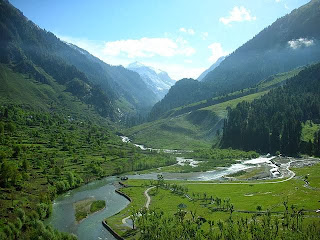A visit to Kargil was certainly a memorable experience, which is also a historical place for Indian army apart from the scenic beauty of the place.
The rough and twisting mountain roads in Kashmir gives you some of the most picturesque views if you are willing to overtake the hardships required in these journeys.
The view from the top is something very unique, as you can experience the beautiful views of green meadows to rocky terrains of different shades of brown, blue and grey, decorated with crystal clear rivers.
The view from the top is something very unique, as you can experience the beautiful views of green meadows to rocky terrains of different shades of brown, blue and grey, decorated with crystal clear rivers.
After staying for a day in the capital city, Srinagar, I went on with my trip towards Leh via the Indian National Highway (NHID), which cuts through Sonamarg, Zoji La, Drass, Kargil, Khaltse, Lamayuru, and Nimmu. The chief itinerary of my trip included a night's stay at Kargil, which is a small town situated at a distance of around 205 km from Kashmir’s capital. The town was torn apart during the months of May and July in 1999, due to the infiltration of Pakistani soldiers and militants into the Indian side of the Line of Control.
As a curfew was declared, we left form Srinagar early on a Sunday morning. The journey was long and tiring, with only two stopovers. The first time we stopped over at a hotel in Sonmarg, to have tea and breakfast as we had left very early from Srinagar. The stop lasted around for 45 minutes. The second stop was for lunch at a small dhabha in Drass, which is the second coldest inhabited place in the world. The temperature over here goes down as low as minus 50 degree Celsius in winter. The lunch consisted of a meal of the scrumptious rajmachawal, after which, we drove to the Kargil War Memorial (Vijay Samarak). Vijay Samarak was built by the Indian Army in honour of those who died in the 1999 war.
This memorial is located at the foot of the Tololing Hill. As reached the spot, I was filled with emotions like selfless service, supreme courage, bravery and sacrifice, all of which was put forward by the Indian soldiers. The Veer Bhumi set up amid the memorial has a tomb, which includes the names of all the soldiers who sacrificed their lives to save their country. On the gateway of the memorial, a poem by Harivansh Rai Bachchan is inscribed, along with stories of the brave soldiers engraved on the stones, across the memorial. As I observed almost all of these stones, I experienced goose bumps at some parts of my body as my entire mind and body got sucked into the emotion of patriotism.
On one of these stones, Captain Vikram Batra’s courageous journey is engraved. On June 1, Captain Batra's unit proceeded to the Kargil Sector to recapture the first peak of importance, Point 5140, located at a height of 17,000 ft. Along with his team, as he ascended the rock-cliff and neared the top; the enemy assaulted them on the face of the bare cliff with machine gun fire. Even after this, Batra, along with five of his remaining men, climbed up and hurled two grenades at the machine gun post, after reaching the top, also killing three soldiers in close combat. He was seriously injured during the process, but still, he regrouped his men to continue the mission. Inspired by Batra's heroic effort, the soldiers of 13 JAK Rifles charged the enemy position and captured Point 5140 in the early hours of June 20. Along with fellow Captain Anuj Nayyar, Batra led his men to victory with the recapture of Point 4750 and Point 4875. Captain Batra, in the end attained martyrdom while tryiing to rescue an injured officer during an enemy counterattack in Point 4875 on July 7.




.jpg)


























+Masjid.jpg)














